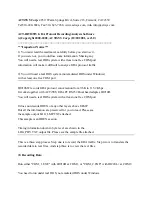
The Primary, the Secondary, and IR910D should be placed very close to each other and all facing
the same direction. Place a white paper in front of all three about 10 cm away. This way all three
can see each other by reflection. Make sure IR910D can hear both both device's talks.
The recorded data is written into a binary file LOG_RAW.BIN.
If you want to keep it, you need to rename it (or copy it) to a different file name. Otherwise, it
will be replaced when you run this program again.
This file can be analyzed and translated into text files.
Note: Each byte of IrDA signal resulted in three bytes in the LOG_RAW.BIN file. The first byte
is the IrDA signal itself (as received by IR910D). The next two bytes is the 16-bit integer
representing the time interval between this IrDA byte and the previous one. The unit of time is
43.58 usec.
(II) Translate To Text Files
Run "XLATE.EXE" to translate LOG_RAW.BIN into LOG_PHY.TXT, LOG_PHY.TXT and
LOG_LMP.TXT files.
(III) Viewing The Text Files
You may use any editor or word processor to view the ASCII text files generated.
These text files are almost self- explanatory.
But be aware of the following:
a) LOG_PHY.TXT also include timing information. However, if the warning message
"Wrong_timing_info!!!" shows up anywhere, the timing information of the entire file is invalid
and should all be ignored. This is usually caused by running DOS under Windows.
b) In LOG_PHY.TXT, the "#_usec" shows the time interval between the EOF of last frame
and first byte of this frame.






















